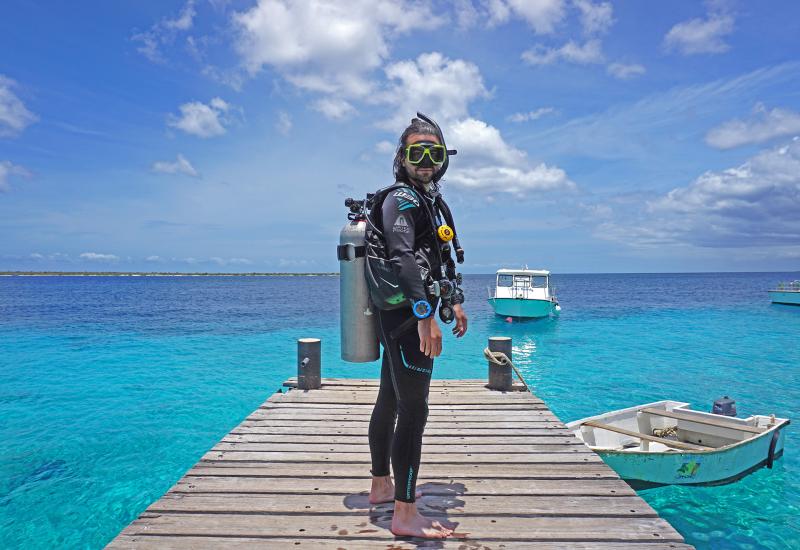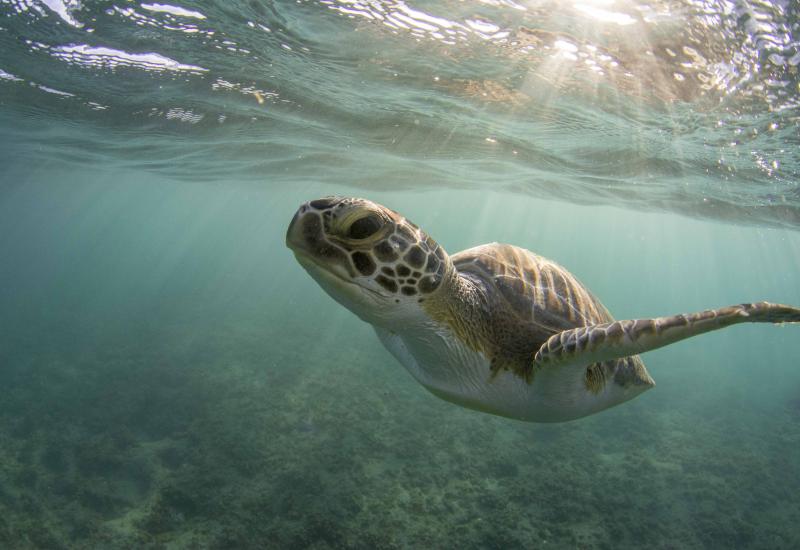Ask An Instructor - January 2007
January 2007
By Michael Ange
Q: I recently took a dive vacation and was surprised to see a tip jar on the dive boat. The crew didn't make any requests for tip money, so I have to ask: What's the rule on tipping the dive crew? And what's a reasonable amount?
A: In many places, especially in the U.S., dive crews are sort of like interns--accumulating hours toward mariner licenses or working toward instructor status. They generally work for tips. Even at resorts with paid boat crews, the mates are low on the pay scale and often rely heavily on gratuities. So, yes, it is common to tip the crew.
There is no hard and fast rule on tip amounts, but here is what I recommend: For adequate service, tip 10 percent of the daily boat fee. For good-quality service, go up from there. I tip 20 percent for exceptional service or when the crew does something really special for my group. The crewmembers generally share tips equally, so if one crewmember stands out I will also tip that individual directly and discreetly. Remember that boat crews rotate fairly often, so you may want to consider tip-ping daily instead of waiting until the end of the week. Good tippers, like courteous divers, are usually rewarded in return with exceptional service and extras, such as the real location of the best lobster holes, or directions on how to find the moray eel that most divers never see. These return "tips" can make your dives more memorable and your cash tips worth every penny.
Q: On my last dive trip, the resort shop offered a selection of steel tanks along with the typical aluminum 80s. What's the practical difference between steel and aluminum cylinders and which one will give me more air?
A: There are pros and cons to both types of cylinders, but let's first deal with which one holds more air. The answer is: It depends--maybe neither.
Both steel and aluminum cylinders come in various sizes. Common aluminum cylinders range in capacity from 13 cubic feet to 100 cubic feet and common steel cylinders range from six cubic feet to 120 cubic feet. A cubic foot of air is the same whether it comes from aluminum or steel vessels--as long as both tanks are filled to their recommended service pressure, an 80-cubic-foot aluminum tank holds the same volume of air as an 80-cubic-foot steel tank.
What often confuses divers is the difference in service pressures. Traditionally, aluminum cylinders are rated for 3,000 psi. Steel cylinders, on the other hand, come in low-pressure varieties, rated to either 2,400 or 2,640 psi, or high-pressure varieties, rated up to 3,500 psi. If you hook up your pressure gauge to a full 80-cubic-foot aluminum tank, your gauge will read 3,000 psi. If I hook my gauge to a full 80-cubic-foot steel tank, it may read only 2,400 psi, but we will have the same volume of gas in our respective tanks.
The real differences to consider between steel and aluminum cylinders are their buoyancy characteristics and their size and weight on dry land. Because steel is stronger than aluminum, a thinner tank wall is required in a steel tank. The steel tank may present slightly smaller dimensions and, perhaps, be a few pounds lighter on the surface than an equivalent-volume aluminum cylinder. What you're most likely to notice, however, is the difference in buoyancy. Steel tanks typically start the dive very negative when they are full and even though they become more buoyant as you consume the gas, they will typically still be a few pounds negative even when empty. In contrast, aluminum cylinders may start the dive two pounds negative when full, but they can be as much as four pounds positive when empty.
Q: Help me settle a bar bet. If you have two divers on an identical profile, wearing the same size cylinder, but one of them breathes the tank down to 500 psi while the other one still has 1,500 psi left, is the air hog (theoretically at least) more likely to get decompression sickness (DCS) than the sipper because he sucked down more air and therefore more nitrogen?
A: It seems logical that the air hog is at greater risk, but if you wagered a round of Red Stripes on that assumption, it's your turn to buy. The consumption of more gas does not, in and of itself, place you at a higher risk for DCS. Most of the gas you breathe (about 95 percent) is simply exhaled back into the water, never entering your bloodstream. Therefore, it will have no impact on inert gas loading and the onset of DCS.
The bigger DCS risk to the air hog is what's causing him to burn through tanks as fast as your friends will down those beers. While high gas consumption can mean something as simple as a larger lung capacity (your lungs inhale and exhale more gas with every breath), it's most often the result of being out of shape for diving. High gas consumption can also come from overexertion or improper techniques like poor buoyancy control or improper fin technique.
Q: I've been open-water certified about a year now and want to take my diving to the next level. My local dive shop offers classes that range from specialty courses to advanced technical training. What courses do you recommend for a diver looking to build her core skills and confidence as a diver?
A: In my opinion, every diver should seek training in navigation, deep diving, night or limited visibility diving, nitrox, and a stress and rescue class. Navigation is a skill that you can use on nearly every dive. A Deep Diver course gives you both the skills and the qualifications necessary to access many unique sites. Night diving is a great confidence builder and it gives you a completely new perspective on the underwater environment. Nitrox allows you to safely expand your dive times on dives between 60 and 130 feet, giving you more dive experience for your buck. Finally, a good stress and rescue class gives you the skills to be truly responsible for your safety.
Once you have developed these core dive skills, then I recommend you explore the specialty options that interest you. When taught by a knowledgeable and enthusiastic instructor, courses like marine life identification and underwater photography (to name just two) can change the way you look at each and every dive.
Q: Simple question: To pee or not to pee in a wetsuit. What's your opinion?
A: According to an old adage, there are just two types of divers: Those who pee in their suit and those who lie about it. For obvious reasons, many divers try not to go in their suits, but it's a simple biological fact that immersing your body in water accelerates the production of urine. If you are a serious diver, eventually you're going to be faced with the really strong urge to go. Unless you want to cut the dive short to find facilities, you may not have much choice in the matter.
Some divers think that restricting fluid intake to reduce the urge is a good solution. It's not. Dehydration is a significant contributing factor, possibly the most significant contributing factor, to decompression sickness. Given the choice between a bout of DCS or a little urine in my suit, I'll take the latter.
If you do urinate in your suit, there are several things you can do to decrease the "yuck" factor. First, try to go at least 15 minutes before the end of the dive. This allows the urine to diffuse out into the water instead of remaining concentrated in your suit. If the temperature allows, you may even want to let some outside water into the suit to help facilitate this process. Flushing the inside of your suit with fresh water when you rinse off after a dive is a good idea. And regardless of which camp you fall into, you should also wash your suit in warm soapy water after every dive trip to prevent odor and bacterial growth.
Got a question you need answered?
E-mail it to [email protected], or write to Ask An Instructor, 6600 Abercorn St., Suite 208, Savannah, GA 31405. safe.
January 2007
By Michael Ange
Q: I recently took a dive vacation and was surprised to see a tip jar on the dive boat. The crew didn't make any requests for tip money, so I have to ask: What's the rule on tipping the dive crew? And what's a reasonable amount?
A: In many places, especially in the U.S., dive crews are sort of like interns--accumulating hours toward mariner licenses or working toward instructor status. They generally work for tips. Even at resorts with paid boat crews, the mates are low on the pay scale and often rely heavily on gratuities. So, yes, it is common to tip the crew.
There is no hard and fast rule on tip amounts, but here is what I recommend: For adequate service, tip 10 percent of the daily boat fee. For good-quality service, go up from there. I tip 20 percent for exceptional service or when the crew does something really special for my group. The crewmembers generally share tips equally, so if one crewmember stands out I will also tip that individual directly and discreetly. Remember that boat crews rotate fairly often, so you may want to consider tip-ping daily instead of waiting until the end of the week. Good tippers, like courteous divers, are usually rewarded in return with exceptional service and extras, such as the real location of the best lobster holes, or directions on how to find the moray eel that most divers never see. These return "tips" can make your dives more memorable and your cash tips worth every penny.
Q: On my last dive trip, the resort shop offered a selection of steel tanks along with the typical aluminum 80s. What's the practical difference between steel and aluminum cylinders and which one will give me more air?
A: There are pros and cons to both types of cylinders, but let's first deal with which one holds more air. The answer is: It depends--maybe neither.
Both steel and aluminum cylinders come in various sizes. Common aluminum cylinders range in capacity from 13 cubic feet to 100 cubic feet and common steel cylinders range from six cubic feet to 120 cubic feet. A cubic foot of air is the same whether it comes from aluminum or steel vessels--as long as both tanks are filled to their recommended service pressure, an 80-cubic-foot aluminum tank holds the same volume of air as an 80-cubic-foot steel tank.
What often confuses divers is the difference in service pressures. Traditionally, aluminum cylinders are rated for 3,000 psi. Steel cylinders, on the other hand, come in low-pressure varieties, rated to either 2,400 or 2,640 psi, or high-pressure varieties, rated up to 3,500 psi. If you hook up your pressure gauge to a full 80-cubic-foot aluminum tank, your gauge will read 3,000 psi. If I hook my gauge to a full 80-cubic-foot steel tank, it may read only 2,400 psi, but we will have the same volume of gas in our respective tanks.
The real differences to consider between steel and aluminum cylinders are their buoyancy characteristics and their size and weight on dry land. Because steel is stronger than aluminum, a thinner tank wall is required in a steel tank. The steel tank may present slightly smaller dimensions and, perhaps, be a few pounds lighter on the surface than an equivalent-volume aluminum cylinder. What you're most likely to notice, however, is the difference in buoyancy. Steel tanks typically start the dive very negative when they are full and even though they become more buoyant as you consume the gas, they will typically still be a few pounds negative even when empty. In contrast, aluminum cylinders may start the dive two pounds negative when full, but they can be as much as four pounds positive when empty.
Q: Help me settle a bar bet. If you have two divers on an identical profile, wearing the same size cylinder, but one of them breathes the tank down to 500 psi while the other one still has 1,500 psi left, is the air hog (theoretically at least) more likely to get decompression sickness (DCS) than the sipper because he sucked down more air and therefore more nitrogen?
A: It seems logical that the air hog is at greater risk, but if you wagered a round of Red Stripes on that assumption, it's your turn to buy. The consumption of more gas does not, in and of itself, place you at a higher risk for DCS. Most of the gas you breathe (about 95 percent) is simply exhaled back into the water, never entering your bloodstream. Therefore, it will have no impact on inert gas loading and the onset of DCS.
The bigger DCS risk to the air hog is what's causing him to burn through tanks as fast as your friends will down those beers. While high gas consumption can mean something as simple as a larger lung capacity (your lungs inhale and exhale more gas with every breath), it's most often the result of being out of shape for diving. High gas consumption can also come from overexertion or improper techniques like poor buoyancy control or improper fin technique.
Q: I've been open-water certified about a year now and want to take my diving to the next level. My local dive shop offers classes that range from specialty courses to advanced technical training. What courses do you recommend for a diver looking to build her core skills and confidence as a diver?
A: In my opinion, every diver should seek training in navigation, deep diving, night or limited visibility diving, nitrox, and a stress and rescue class. Navigation is a skill that you can use on nearly every dive. A Deep Diver course gives you both the skills and the qualifications necessary to access many unique sites. Night diving is a great confidence builder and it gives you a completely new perspective on the underwater environment. Nitrox allows you to safely expand your dive times on dives between 60 and 130 feet, giving you more dive experience for your buck. Finally, a good stress and rescue class gives you the skills to be truly responsible for your safety.
Once you have developed these core dive skills, then I recommend you explore the specialty options that interest you. When taught by a knowledgeable and enthusiastic instructor, courses like marine life identification and underwater photography (to name just two) can change the way you look at each and every dive.
Q: Simple question: To pee or not to pee in a wetsuit. What's your opinion?
A: According to an old adage, there are just two types of divers: Those who pee in their suit and those who lie about it. For obvious reasons, many divers try not to go in their suits, but it's a simple biological fact that immersing your body in water accelerates the production of urine. If you are a serious diver, eventually you're going to be faced with the really strong urge to go. Unless you want to cut the dive short to find facilities, you may not have much choice in the matter.
Some divers think that restricting fluid intake to reduce the urge is a good solution. It's not. Dehydration is a significant contributing factor, possibly the most significant contributing factor, to decompression sickness. Given the choice between a bout of DCS or a little urine in my suit, I'll take the latter.
If you do urinate in your suit, there are several things you can do to decrease the "yuck" factor. First, try to go at least 15 minutes before the end of the dive. This allows the urine to diffuse out into the water instead of remaining concentrated in your suit. If the temperature allows, you may even want to let some outside water into the suit to help facilitate this process. Flushing the inside of your suit with fresh water when you rinse off after a dive is a good idea. And regardless of which camp you fall into, you should also wash your suit in warm soapy water after every dive trip to prevent odor and bacterial growth.
Got a question you need answered?
E-mail it to [email protected], or write to Ask An Instructor, 6600 Abercorn St., Suite 208, Savannah, GA 31405. safe.










